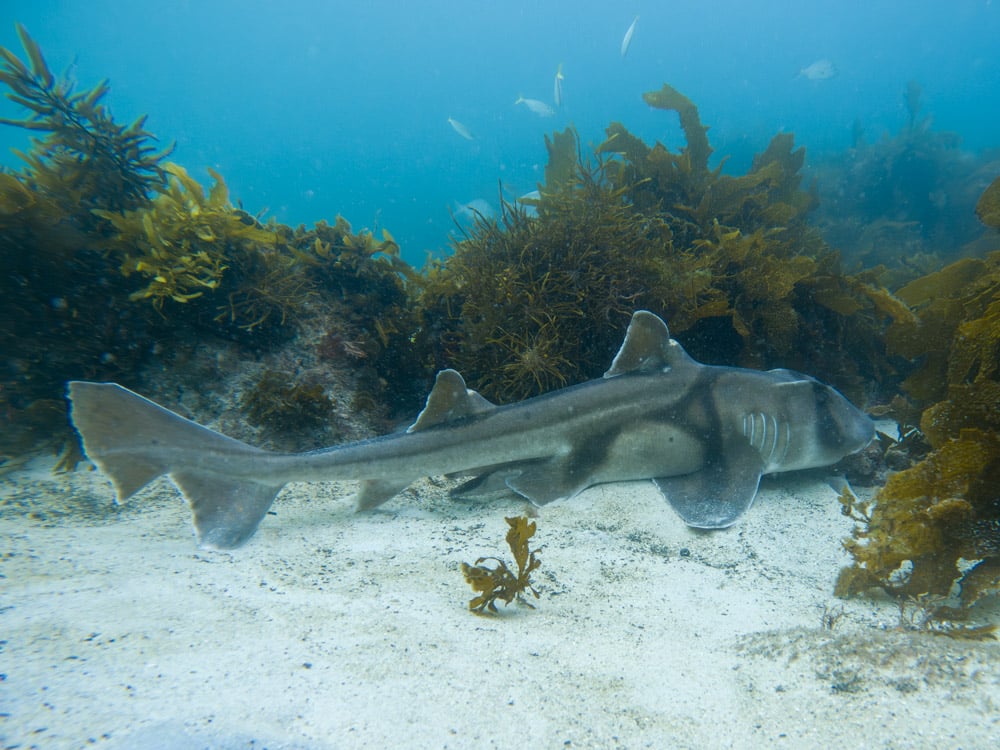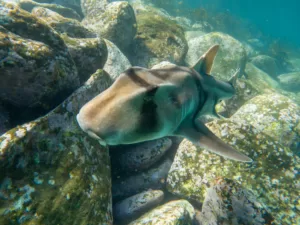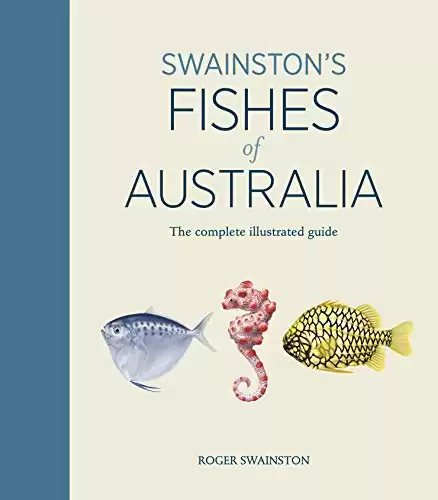Heterodontus portusjacksoni, commonly known as the Port Jackson shark, is a widely distributed species endemic to the southern coastline of Australia. It is much loved by snorkelers and divers alike, thanks to its somewhat unusual appearance, peaceful nature, and the fact that it can be found in shallow waters. Snorkelling with Port Jackson Sharks is one of those things you should definitely put on your reef bucket list.
Identifying the Port Jackson Shark
Port Jackson Sharks are relatively small, reaching up to 1.65 meters (5.4 feet). Their unique physical features make them easy to identify.
Their bodies are grey-brown, adorned with black harness-like markings across the eyes, dorsal fins, and down their back. The most distinctive feature though, is their teeth. They have a unique dental arrangement – small, pointed teeth at the front for grabbing prey, and larger, flat ones at the back for grinding hard-shelled animals like molluscs and crustaceans.


Lifecycle
Life for a these sharks begins within a distinctive corkscrew-shaped egg that could easily be mistaken for a piece of seaweed. These twisty cases are deposited by their mothers into rocky crevices, protecting the baby sharks from predatory threats.
Want to spot new fish species? This book by Nigel March documents 100 diving and snorkeling spots across Australia, and which species might be found there.


After about 10 to 11 months of gestation, the shark pups hatch, already perfectly formed miniatures of their parents. Reaching maturity at around 10-14 years, these sharks have been known to live for more than 25 years, swimming the coastal floors of southern Australia and laying their fascinating eggs year after year.
Looking for a handy guide to identify your observations on the go? We recommend Fishes of Australia, the complete illustrated guide.
Distribution and Conservation
Port Jackson Sharks are native to the southern coast of Australia. As the name suggests, they frequent the waters around Port Jackson (Sydney Harbour), but their range extends from southern Queensland, all the way around to the western coast of Australia.
At this moment, they is listed as ‘Least Concern’ on the IUCN Red List, due to its widespread distribution and lack of significant threats. It’s always a delight for marine enthusiasts to know that a species is thriving, and it gives us even more reason to respect and preserve their habitats.
Port Jackson Shark Encounters
Being docile and generally unthreatened by human presence, Port Jackson Sharks are ideal for snorkelling adventures. The best spots to swim with these wonderful creatures are around Sydney, particularly Shelly Beach, Bare Island, and Clovelly. Further south you can also find them in Bushrangers Bay, or on the many sites at Jervis Bay. During the breeding season, which lasts from late winter to early spring, there is a higher chance of seeing them outside of their hiding spots.
Remember, though, while they’re not aggressive, they can get territorial during the mating season. When snorkelling with Port Jackson Sharks, it is essential to maintain a respectful distance and avoid disturbing their natural behaviour.
Behaviour and Character
These sharks are night owls (or should we say, night sharks!). They’re nocturnal creatures, preferring to rest during the day and actively hunt at night. They have a unique social behaviour too, gathering in large groups, sometimes with hundreds of individuals, especially during the breeding season.
Their docile and calm nature makes them great ambassadors for shark species worldwide. They defy the stereotypical ‘dangerous shark’ narrative and offer an excellent opportunity for us to reframe our understanding of these magnificent creatures.
More sharks

Distribution
Southern coastline of Australia
Facts
Common Size: 100 cm
Max Size: 164 cm
Depth: 0-180m
Lifespan: 30+ years
Risk and Safety
Low risk: The sharks can be approached, but can get moody in the breeding season.
Conservation
IUCN Status: Least Concern
Population Trend: Stable


